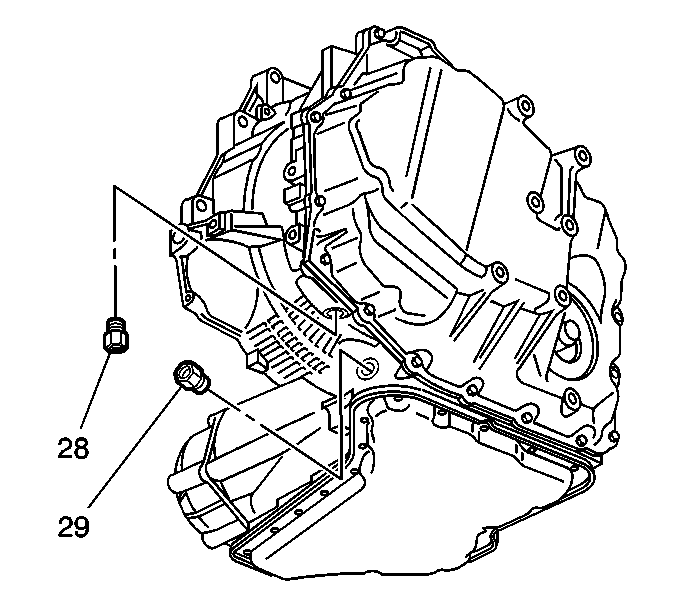Removal Procedure
- Raise and support the vehicle. Refer to Lifting and Jacking the Vehicle in General Information.
- Position a drain pan under the vehicle.
- Remove the transaxle oil cooler hoses from the transaxle oil cooler fittings. Refer to Automatic Transmission Oil Cooler Pipes Replacement .
- Remove the transaxle oil cooler fittings (28,29) from the transaxle.

Notice: Allow sufficient clearance around the transaxle oil cooler pipes and around the hoses to prevent damage or wear which may cause fluid loss.
Installation Procedure
- Apply sealant to the transaxle oil cooler fittings (28,29).
- Install the transaxle oil cooler fittings (28,29) to the transaxle.
- Install the transaxle oil cooler hoses to the transaxle oil cooler fittings. Refer to Automatic Transmission Oil Cooler Pipes Replacement .
- Lower the vehicle.
- Adjust the fluid level. Refer to Transmission Fluid Check .
- Inspect for fluid leaks. Refer to Fluid Leak Diagnosis .
- Remove the drain pan from under the vehicle.

Notice: Use the correct fastener in the correct location. Replacement fasteners must be the correct part number for that application. Fasteners requiring replacement or fasteners requiring the use of thread locking compound or sealant are identified in the service procedure. Do not use paints, lubricants, or corrosion inhibitors on fasteners or fastener joint surfaces unless specified. These coatings affect fastener torque and joint clamping force and may damage the fastener. Use the correct tightening sequence and specifications when installing fasteners in order to avoid damage to parts and systems.
Important: The correct thread engagement is critical. Crossthreaded fittings can achieve proper tightness and still leak.
| • | For green inlet cooler fitting GM P/N 8651654. |
| • | For outlet cooler fittings GM P/N 24202550. |
| • | For line pressure plug GM P/N 8654382. |
Tighten
Tighten the transaxle oil cooler fittings (28,29) to 38 N·m
(28 lb ft).
Notice: Do NOT overfill the transaxle. The overfilling of the transaxle causes foaming, loss of fluid, shift complaints, and possible damage to the transaxle.
